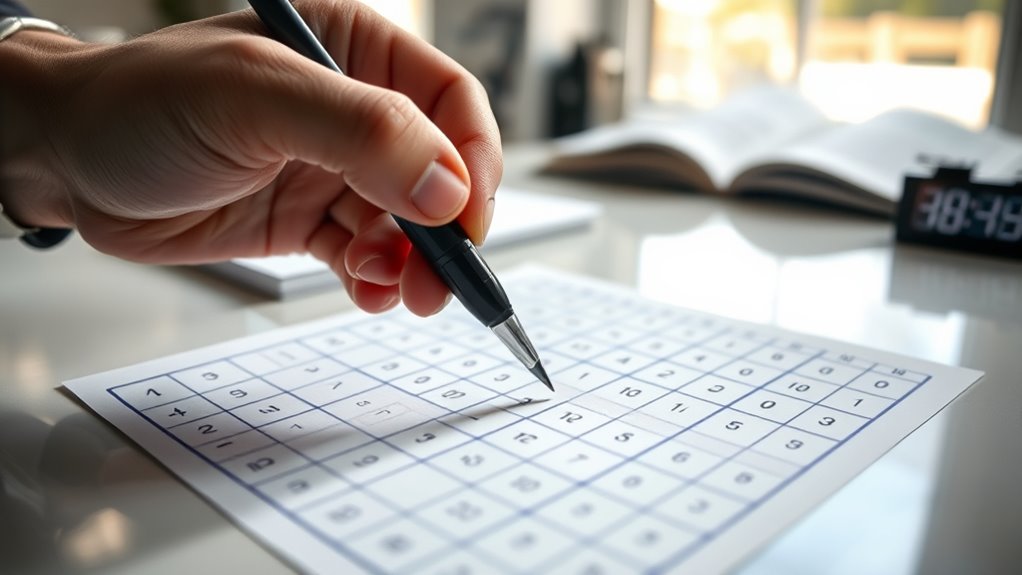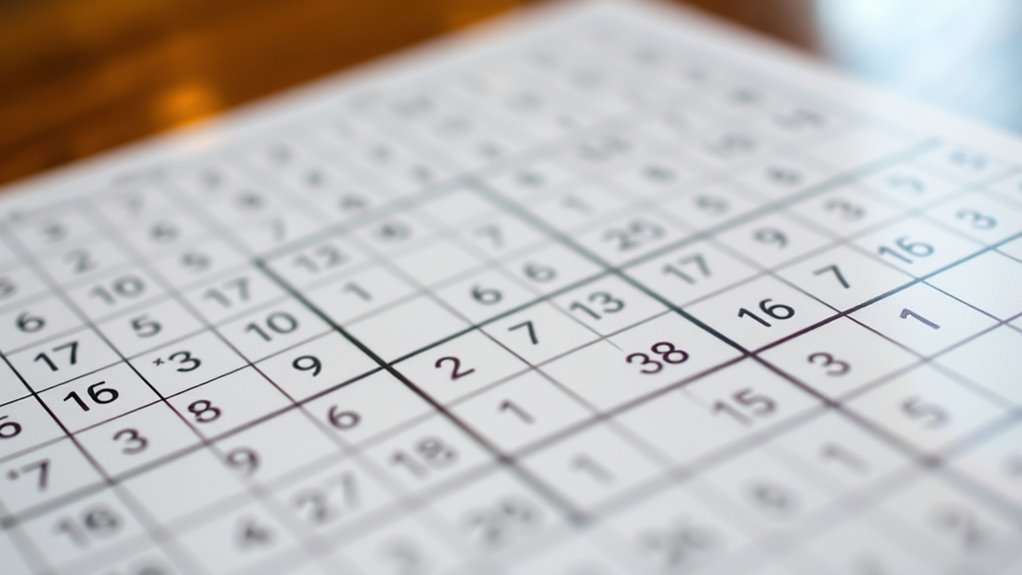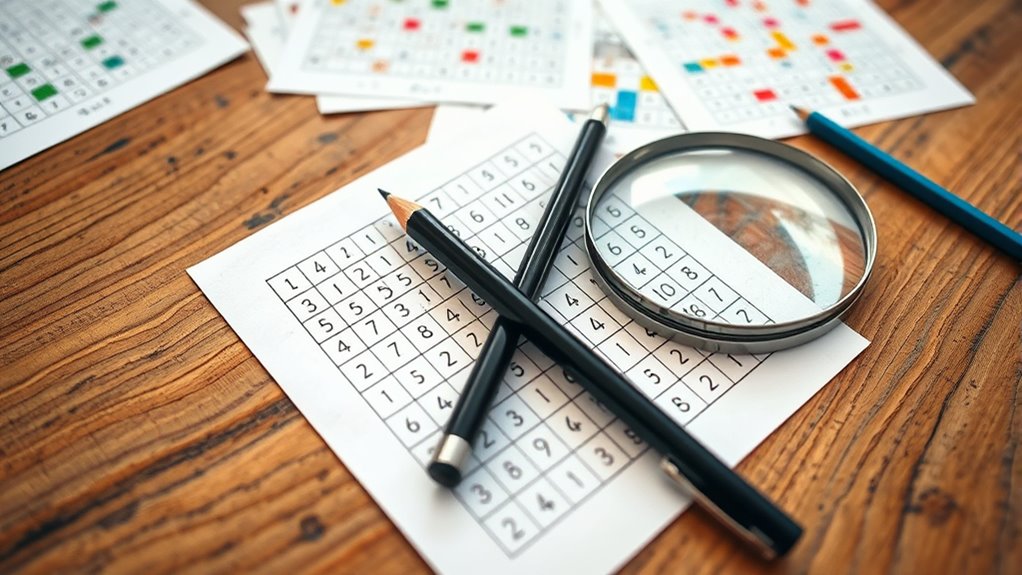To become a top Sudoku solver, start with basic techniques like eliminating candidates based on existing digits and recognizing common patterns such as pairs or triples. Use pencil marks carefully to keep track of possibilities and update them regularly for clarity. Then, move on to advanced strategies like hidden sets and candidate elimination to tackle tough puzzles. Mastering these methods builds a solid foundation, so if you keep exploring, you’ll improve your skills even further.
Key Takeaways
- Master basic techniques like digit elimination and pattern recognition to simplify the puzzle effectively.
- Use pencil marks consistently to organize potential candidates and visualize possibilities clearly.
- Identify common arrangements such as pairs, triples, and hidden sets to narrow down options quickly.
- Analyze row, column, and box interactions to eliminate impossible candidates and uncover hidden clues.
- Progress from foundational skills to advanced strategies by practicing structured analysis and pattern recognition.
Recognizing and Applying Basic Techniques

To effectively solve Sudoku puzzles, you first need to recognize and apply basic techniques that form the foundation of more advanced strategies. One key skill is digit elimination, which involves ruling out numbers from certain cells based on existing digits in the row, column, or box. This process helps narrow down possibilities and simplifies your choices. Equally important is pattern recognition—identifying common arrangements such as pairs, triples, or other configurations that repeat across the grid. Spotting these patterns allows you to make logical eliminations quickly and efficiently. Developing an understanding of puzzle structure can further enhance your ability to identify opportunities for deduction. By honing your ability to recognize these fundamental patterns and applying digit elimination consistently, you build a solid base for tackling more complex puzzles with confidence.
Using Pencil Marks Effectively

Using pencil marks effectively transforms guesswork into logical deduction. Proper pencil mark management helps you keep track of potential numbers in each cell, making it easier to spot patterns and eliminate possibilities. To do this efficiently, maintain notation consistency by using a uniform system—such as small digits in the corners—that clearly indicates potential candidates. Avoid clutter by updating your pencil marks regularly; remove candidates once they’re invalidated by new deductions. Be disciplined with your notation, so you don’t miss important clues or create confusion. Consistent, organized pencil marks allow you to visualize the puzzle more clearly, guiding you toward logical solutions without unnecessary guessing. Mastering pencil mark management is essential for progressing smoothly through even challenging Sudoku puzzles.
Advanced Strategies for Difficult Puzzles

When facing particularly challenging Sudoku puzzles, advanced strategies can make the difference between frustration and success. Pattern recognition becomes essential; by spotting unique arrangements or repeating patterns, you can narrow down possibilities quickly. Look for hidden pairs, triples, or other sets that aren’t immediately obvious. Candidate elimination is also critical—by carefully analyzing how certain numbers interact within rows, columns, and boxes, you can remove impossible options. This process helps you focus on fewer candidates, increasing your chances of making confident placements. Combining pattern recognition with candidate elimination allows you to uncover hidden clues and solve complex puzzles more efficiently. Mastering these techniques takes practice, but they’re fundamental tools when standard methods no longer suffice.
Frequently Asked Questions
What Are Common Mistakes Beginners Make When Solving Sudoku?
When tackling Sudoku, you often fall into common pitfalls or make beginner errors, like overlooking obvious numbers or rushing through puzzles. You might also forget to double-check rows, columns, or boxes, which leads to mistakes. Another mistake is assuming a number fits without confirming all possibilities. By slowing down, carefully analyzing each move, and avoiding these beginner errors, you’ll improve your solving skills and increase your success rate.
How Can I Improve My Sudoku Solving Speed?
To improve your Sudoku solving speed, focus on developing your mental agility and mastering advanced techniques like X-wing, swordfish, and coloring. Practice regularly to recognize patterns quickly and eliminate possibilities faster. Break the puzzle into sections and avoid rushing; instead, trust your instincts. As you become more confident with these strategies, you’ll solve puzzles more efficiently, boosting both your speed and accuracy over time.
Are There Specific Sudoku Variants That Help Develop Skills?
Think of Sudoku variants as different tools in your skill-building toolbox. Playing variants like Killer Sudoku or Samurai Sudoku challenges you to think differently, sharpening your logic and pattern recognition. These puzzles are like cross-training for your brain, helping develop skills that transfer to standard Sudoku. By exploring these variants, you boost your problem-solving abilities and become a more versatile solver, making your overall Sudoku game stronger and more adaptable.
What Tools or Apps Can Assist in Practicing Sudoku?
You can enhance your Sudoku skills by using various tools and apps designed for practice. Digital puzzles are available on many platforms, offering different difficulty levels to challenge you. Online resources like Sudoku websites and mobile apps provide interactive features, hints, and tutorials that help you learn and improve. With consistent practice using these tools, you’ll develop your logic and problem-solving skills more effectively.
How Do I Maintain Motivation During Challenging Puzzles?
Imagine you’re stuck on a tough puzzle, feeling frustrated. To maintain motivation, focus on building mental resilience by setting small, achievable goals, like solving one section at a time. Celebrate each success to boost confidence. Remember, persistence matters. Keep reminding yourself of your progress, and don’t be afraid to take breaks. This approach helps you stay motivated, even during challenging puzzles, and improves your overall problem-solving skills.
Conclusion
So, after all that, you might think Sudoku is just a simple number puzzle. Yet, even with these strategies, the toughest puzzles can still trip you up. Ironically, the more you learn, the more elusive that perfect solution becomes. But don’t get discouraged—every mistake is just another step toward mastery. Keep practicing, because someday, you’ll solve that impossible grid and realize it was all worth the frustration.







